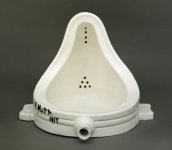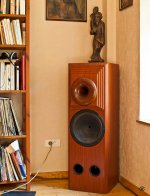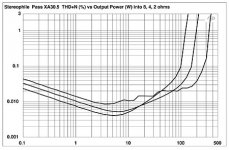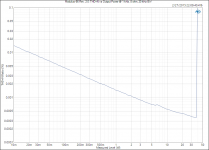Horns? Did somebody mention horns!
Attachments
When the self-centred advance they too often tend to systematically remove competition from below thereby ending up as bloated big-fish in a shrunken to zero pond...............pleased not to be a share-stock holder. And they - not surprisingly - often have dominant wives with expensive handbag tastes!
At this moment, my business associate is listening to the same K-horn(s) that I used between 1967-1980 on FM to the 'Prairie Home Companion', one of the last 'hi fi' programs on FM. He is not unhappy with the sonics. They sure beat normal direct radiators.
Now, I know and understand the limitations of K-horns. I first met Paul Klipsch in 1966, and we remained colleagues at AES conventions for several years. In 1965, I owned an AR-1 with and added tweeter, that I had played with for years, driven by a pair of Dyna Mk-3's and a 3.3 ohm series resistor (DF of 1). In late 1965, I started working part-time for the K-horn dealer in Berkeley, and then I was introduced to the K-horn. It really worked for the music that I liked at the time: large symphonic pieces and jazz. It just made my AR setup sound compromised, and when I could, I got my first K-horn.
I was very happy with the K-horn for several years, when in 1970 I added another to get stereo. This was my first 'let-down' with the K-horn, as I could only get 'ping pong' stereo from it, and no real central image. Then, while working with John Meyer (Meyersound) we went through the limitations of the K-horn, especially the time delays between the drivers. In 1974, we designed an improved 3 way, 'time aligned' all horn loaded speaker system, that probably had 10 times less distortion, and better, more accurate time arrival. It took 3 separate amps (the JC-3 power amp was developed just for the tweeter), and a 1-3ms switched analog gate delay to get it aligned. It WAS better but at 10 times the price as well. Not practical for home use at the time. As time passed, I went back to my K-horns, and they were 'flawed' but OK for several years. Finally, I just could not stand the 'time delay' between the drivers and switched over to a pair of Rogers LS3-5A's and a pair of sub-woofers, and sold my K-horns to one of my best friends. Still, the K-horns were good to great for their time, especially in mono.
Now, I know and understand the limitations of K-horns. I first met Paul Klipsch in 1966, and we remained colleagues at AES conventions for several years. In 1965, I owned an AR-1 with and added tweeter, that I had played with for years, driven by a pair of Dyna Mk-3's and a 3.3 ohm series resistor (DF of 1). In late 1965, I started working part-time for the K-horn dealer in Berkeley, and then I was introduced to the K-horn. It really worked for the music that I liked at the time: large symphonic pieces and jazz. It just made my AR setup sound compromised, and when I could, I got my first K-horn.
I was very happy with the K-horn for several years, when in 1970 I added another to get stereo. This was my first 'let-down' with the K-horn, as I could only get 'ping pong' stereo from it, and no real central image. Then, while working with John Meyer (Meyersound) we went through the limitations of the K-horn, especially the time delays between the drivers. In 1974, we designed an improved 3 way, 'time aligned' all horn loaded speaker system, that probably had 10 times less distortion, and better, more accurate time arrival. It took 3 separate amps (the JC-3 power amp was developed just for the tweeter), and a 1-3ms switched analog gate delay to get it aligned. It WAS better but at 10 times the price as well. Not practical for home use at the time. As time passed, I went back to my K-horns, and they were 'flawed' but OK for several years. Finally, I just could not stand the 'time delay' between the drivers and switched over to a pair of Rogers LS3-5A's and a pair of sub-woofers, and sold my K-horns to one of my best friends. Still, the K-horns were good to great for their time, especially in mono.
stick with
My prof expressed criticism many a time on the way Delft-U was run, even in an interview published in Delta, the university weekly, then the Grand Poo-Bah & Co threw him out. Which still was somewhat of a surprise, as he is/was a mighty cash-cow rancher, huge network.
Whether it is smarter to speak out too much, or too little, is a personal choice.
https://www.youtube.com/watch?v=Cx_fh8yqs8Q
Far far less John-Cheese in French, PTL. He run/owned a shipping company in France before he got the academic itch, his wife is French.
A'dam is tops for guys of the couple/single persuasion. As the Castro/SF, but less uptight, imo : fag with a shmoke and a pancake. I went to G-dance clubs in A'dam with/without G-men and straight women, talked shop with various nationality specimens about past, present and future over coffee and a sandwich at 4am.
(I merely take pleasure in non-pc and imitating Christopher Walken)
Once again :-(I'd say once your ear tunes in, Horns have a 'beguiling' sound. It's pleasurable, but it's not accurate.
Horns are certainly more accurate than cones of dynamic speakers, when correctly designed, with a good driver. They allow a 700/ 16000 range from an unique point source, and you know the benefit.
They can be awfull, but, correctly designed, it is the best compromize I know, for the moment, between linearity, fast transients with fast dumping, high dynamic and... low distortion at normal levels.
Everybody need, one day or an other to listen to a good 'spherical wave' horn system, le clearch based. And it is ennough to record one of those, in comparizon to any menbrane one to be convinced of their "accuracy". And, about size:
Attachments
father from Nijmegen
I did hard-time at the Jesuit private school for boys in Nijmegen.
Us Catholic boys are destined to self-flatulate till our final day, then someone else may or will take over.
The way my nose is heading, I may end up in deeper than what I'm smelling at current.
Le Cleac'h
Better than spending a lot of time in the loo.I grew up with a small but visible Dutch expat community and worked at 16 for a certain Mr. Van de Loo. I joke sometimes that I have spent more time in the last 20 yr. in Grande Place Brussels than downtown Boston.
The noise contribution to THD+N is an interesting one, and one I have never seen much discussion regarding is there a 'best' shape for this. First attachment is THD+N for the Pass XA30.5 which is highly rated and award winning. This follows the shape that most of the amplifiers I have seen measured follow, with the minimum around -10dB from peak, below which noise dominates, above which distortion dominates. As that last 10dB is only for the biggest peaks or the odd head bang, this seems to be eminently sensible.
Second is the same for an amplifier I'm currently building a quartet of to switch to active drive on my speaker. It's the best I can afford at the moment , and although the design will not tick the boxes with many (not big, not heavy, can't jump start cars) it measures pretty well. You can see with this one THD+N continues to decrease until clipping is reached, so inferring its noise limited. As the noise floor is down in the weeds and it could be said this is as good as you need to be for this particular measurement.
, and although the design will not tick the boxes with many (not big, not heavy, can't jump start cars) it measures pretty well. You can see with this one THD+N continues to decrease until clipping is reached, so inferring its noise limited. As the noise floor is down in the weeds and it could be said this is as good as you need to be for this particular measurement.
But when you do have to trade noise or THD, which way do you go?
(for the record, when operated within a common operating area I would not expect to be able to tell the difference between those two amps. )
Second is the same for an amplifier I'm currently building a quartet of to switch to active drive on my speaker. It's the best I can afford at the moment
But when you do have to trade noise or THD, which way do you go?
(for the record, when operated within a common operating area I would not expect to be able to tell the difference between those two amps. )
Attachments
It was a bit more complicated than that, but I should probably not go much further in here. I wish Greg the best, and although it came as a complete surprise, he was taking it well according to some closer friends. He is also quite comfortable and has stated that he doesn't need to work, but wants challenges.JBL/Harman just doesn't seem to understand talent. Marketing is the game, they always seem to get rid of the best and brightest at some point. Some director of financing probably decided he was costing to much and a one year graduate engineer should be interchangeable!
As far as Harman management, I can cite two events to indicate how astute it is. The first was when Dinesh Paliwal called Sean Olive to congratulate him on being the AES President-elect, and after a short conversation with the quite-surprised SO, was asked by DP "And, so what is the AES anyway?"
Then after I was kicked out in late 2004, DP told people in the Multimedia portion of Harman Consumer that they could keep their jobs on the condition that they move to China. Now nothing against the balance of people in Consumer, but Multimedia was a pretty functional group, had a great industrial designer doing things (until Gina Harman reneged on Kurt's contractual agreements made by her predecessor), and was the only portion of Consumer that was turning a profit (of course balance sheets were massaged, fully legally, to distort the realities).
It is no surprise that Devantier was able to persuade a good number of Consumer engineers to join his new group at Samsung.
There are a few good people left, but for how long I have no idea.
Harman is primarily an automotive company. Pro makes money but preserving brand perception/recognition is the bottom-line motivation, ditto the Consumer products. Ditto the Luxury Audio products like Mark Levinson and Revel. In fact, the OEM computer audio business that Harman exited because of the low margins and high liabilities was prized by Sidney and Bernie Girod as much or more for getting old brands like Harman/Kardon in front of a younger generation by virtue of the branding of those OEM little systems, than for making any money. JBL at least had the brand recognition from the Pro group, for those who saw the logos in stadiums and clubs.
Absolutly. it is hard to build a two ways system because we are at the limit of the range of the two units. need a high slope fiter.Midrange horns can be very accurate, these last few decades. The problem is the interface to a direct radiator for the bottom, as well as adding a tweeter (to make the audio bandwidth, truly extended).
I believe the solution is to have a sub, and use a speaker of a reduced diameter for the basses/low medium. But we have an advantage: the diameter of the horn can be the same order than the one of the basses, so same directivity at the crossing frequency.
For tweeters, i do agree, as i always failed. But I dont feel the need on my system: Because my age and reduced hearing bandwidth ?
The only thing I can assure is there is no traces of any "duck" or nasal sound. Very natural, easy, *separated,* dynamic. You can discover things like nails on the guitars, sticks on the cymbals, that I never noticed on my traditional speakers on the same records because they were flooded in the note.
And on good recorded voices, or difficult instruments like Piano, closing the eyes, you can believe the artist or the instrument is in your room.
Last edited:
I'm tempted to say you don't have to trade. But I recall when Keith O. Johnson mentioned JFETs in the front end of a Spectral amplifier and said that they were smaller-geometry devices than might have been used, hence slightly higher noise, but that they were better for other parameters including bandwidth and fast settling. The psychoacoustics of such concerns are at best controversial, but that's what he said iirc.ment.
But when you do have to trade noise or THD, which way do you go?
And as is often the case, your source component is usually the dominant source of noise in the system, so pushing noise down further is more for bragging rights and marketing in many cases.
I'm tempted to say you don't have to trade.
<snip>
And as is often the case, your source component is usually the dominant source of noise in the system, so pushing noise down further is more for bragging rights and marketing in many cases.
I'm not sure either, hence why I threw it open to the more experienced here. At least for my modest power requirements (both V and I) I can have my cake and eat it. But for those who really must have max SPLs and aren't running horns it can get challenging to make a 500W unit with a noise floor as low as a 50W one?
Edit: But having a power amp cleaner than my DAC has a certain perverse charm
Christophe,
Your horn system is more like what I grew up with with a large 15" cone driver and then a horn on top. It wasn't until I was doing work with stage monitors that I started to think differently and went to a three way system with a cone driven mid-range horn. On the stage for singers that made such a difference in the sound getting away from either to much top end on the cone driver or pushing the compression driver down to low. Since that time I just have tended to go in that direction and use a cone driven mid horn, it just cleans up that problem area, voices just sound much more natural. Efficiency isn't a real problem, it is still a horn and the lower cone driver always has trouble keeping up, so the loss from using a compression driver in that range is not a real problem.
I still like what I've done with horns, it is just not something that most younger consumers have any exposure to except in a large stadium as Ed does or in smaller clubs where most of the time the sound isn't great to put it lightly. Some of the latest Pro audio line arrays have some pretty well thought out horn arrays. The bottom end may still be massive arrays of direct radiators but it is a long way from the days I was moving around Altec A2 enclosures and RCA W-horns for sure.
Your horn system is more like what I grew up with with a large 15" cone driver and then a horn on top. It wasn't until I was doing work with stage monitors that I started to think differently and went to a three way system with a cone driven mid-range horn. On the stage for singers that made such a difference in the sound getting away from either to much top end on the cone driver or pushing the compression driver down to low. Since that time I just have tended to go in that direction and use a cone driven mid horn, it just cleans up that problem area, voices just sound much more natural. Efficiency isn't a real problem, it is still a horn and the lower cone driver always has trouble keeping up, so the loss from using a compression driver in that range is not a real problem.
I still like what I've done with horns, it is just not something that most younger consumers have any exposure to except in a large stadium as Ed does or in smaller clubs where most of the time the sound isn't great to put it lightly. Some of the latest Pro audio line arrays have some pretty well thought out horn arrays. The bottom end may still be massive arrays of direct radiators but it is a long way from the days I was moving around Altec A2 enclosures and RCA W-horns for sure.
Note, please that i did a mistake. My horn is smaller than the cone, and that is not good. So I'm obliged to use an electrical 24dB/oct filter. If i was courageous enough, i would build an other enclosure with a sub and a high efficiency 10" or 8" bass medium.Your horn system is more like what I grew up with with a large 15" cone driver and then a horn on top.
I know, like you, and hate all those PA horns (i managed a big PA system with those old JBL PA horns, resonating everywhere with response curves like shark teeth ;-)
http://img.canuckaudiomart.com/uploads/large/203205-jbl_2350_horns.jpg
http://i.ytimg.com/vi/HjpVI8Z48bA/maxresdefault.jpg
How about an example. Let's consider VFAs.I'm not sure either, hence why I threw it open to the more experienced here. At least for my modest power requirements (both V and I) I can have my cake and eat it. But for those who really must have max SPLs and aren't running horns it can get challenging to make a 500W unit with a noise floor as low as a 50W one?
Edit: But having a power amp cleaner than my DAC has a certain perverse charm
Say that our front end is made of transistors with 1nV/sq rt Hz noise density devices. Suppose we want the sensitivity for full output to be the same for each amp.
So suppose it's 50W or 500W into a nominal 8 ohm load. Thus we have either 20V RMS or 63.2V RMS. Suppose the sensitivity for full output is 1V RMS in.
Suppose we incur the noise of an input differential pair, hence an input e sub n from the active devices of 1.414nV/sq rt Hz. In order not to spoil this with noise in the feedback network, which will be dominated by the feedback divider resistor, let's make that contribution three times lower than e sub n.
An equivalent contribution would be from a 121 ohm resistor (approximately). To make the contribution three times less we need something nine times smaller (!). So that starts requiring some serious currents and corresponding dissipation in the feedback resistor. I get about 13.4 ohms for the divider R and 19 times that for the feedback R of 255 ohms. With full power out that latter will dissipate 1.42W average power (19V RMS across the feedback R). Not too bad. If the noise is mostly white the net output noise will still be rather small. I'll leave that calculation as the proverbial exercise for the reader.
Suppose the same front end design is used for the 500W amp. Well, since we have 3.16 times more gain, we know we will be that much worse off in the e sub n contribution, and input divider resistor thermal noise, to output noise. But still not bad. However if our input R is still 13.4 ohms our feedback R will be 833 ohms and our dissipation at full output now 4.64W. Note that resistor self-heating, and not just the power rating, will have to be considered as a factor in the distortion (although if the feedback R is made out of a string of the same parts as the divider resistor we can alleviate the effects). And resistor excess noise is also rearing its head, so components need be selected with care.
So yes, it is harder both for noise, and for distortion mechanisms that we might normally ignore. But that noise in both examples is almost silly-low, and will require a great deal of care in the other mostly-deterministic noise sources to be the limitation. It could still be lower with more/larger input devices and more dissipation in the feedback network, if anyone cared.
Nicely put 
So if we can put distortion to bed (at least the way it's normally measured) as in a few ppm and we can put noise to bed as being below any sane noise floor of a room, what is left in defining state of the art amplification? Any new frontiers left performance wise?
So if we can put distortion to bed (at least the way it's normally measured) as in a few ppm and we can put noise to bed as being below any sane noise floor of a room, what is left in defining state of the art amplification? Any new frontiers left performance wise?
IIANM, the LHS distortion plot is on s linear scale. Might be easier to compare if both are log.
The NP amp is clearly low or no feedback. After 10 W the distortion climbs out of the noise floor finally you have soft clipping at a hundred watts or so.
The second amp looks like a high F/back exemplar - distortion close to the noise floor until is clips.
Two very different amps
The NP amp is clearly low or no feedback. After 10 W the distortion climbs out of the noise floor finally you have soft clipping at a hundred watts or so.
The second amp looks like a high F/back exemplar - distortion close to the noise floor until is clips.
Two very different amps
- Status
- Not open for further replies.
- Home
- Member Areas
- The Lounge
- John Curl's Blowtorch preamplifier part II



